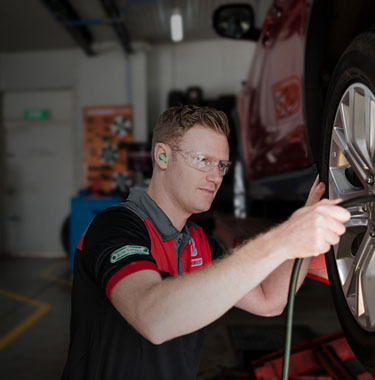Checking Tyre Pressure
Learn how to check your tyre pressure and inflate your tyres
Tyre pressure is a measurement of how much air is in your tyre, and ensures tyres wear evenly and maintain the correct level of grip with the surface.
As tyres naturally lose air over time, it's crucial to regularly check your tyre pressure. Without this maintenance, you risk losing grip, lengthening braking distances, damaging tyres, shortening their lifespan, and increasing fuel consumption. Save fuel, increase on-road safety, and get more life out of your tyres by making sure they are properly inflated.
We explain how to check your tyre pressure and pump up your tyres.
Tyre pressure
Why it's important to check your tyre pressure?
When was the last time you checked the pressure of your tyres? If you haven’t checked your tyres in over a month, then you might just be wasting fuel, and risking your safety.
Correct tyre pressure is important for three main reasons:
- Badly inflated tyres make it harder to handle your car on the road, impairing your ability to steer, corner, accelerate and brake.
- Incorrect inflation wears your tyres down quicker, as the wrong parts of the rubber make contact with the road.
- Insufficient tyre pressure increases rolling resistance on the road, causing your car to use more fuel.
How to check tyre pressure?
To check tyre pressure, find the recommended PSI in your manual or Placard Sticker which is usually found in the vehicles door. Use a tyre pressure gauge on cold tyres, removing the valve cap first. Press the gauge onto the valve stem firmly to get a reading. Compare this with the recommended pressure. If low, add air using a compressor; if high, release air. Repeat for all tyres, including the spare. Replace valve caps securely. Regularly monitor tyre pressure, checking at least monthly and before long trips.
Proper pressure ensures safety, extends tyre life, and improves fuel efficiency.
Tyre inflation
How to inflate your tyres?
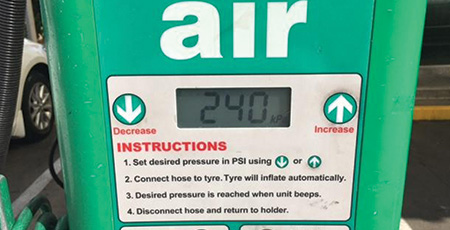
Air Compressor
To refill your tyres to the correct pressure, you’ll need an air compressor. You can buy a portable air compressor from an auto parts store, but we recommend you simply pop into a petrol station. Air compressors there are usually free, and most can automatically fill your tyre to a chosen pressure.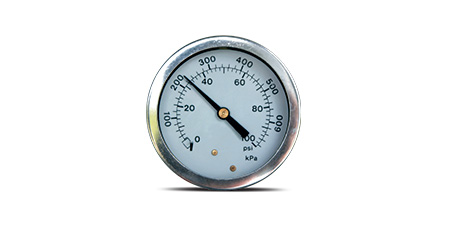
Tyre Pressure Gauge
For the best results, you’ll also need a tyre pressure gauge.You can use a manual gauge, or upgrade to a digital gauge
for an easier experience.
Ensure your tyres are cold
We also recommend you check for pressure and inflate your tyres when they are cold. Your tyres will be cold if your car has been parked for at least three hours, or has been driven less than 2km at a moderate speed. So it’s best to find a petrol station that’s close by.Learn how to check your tyre tread with our simple test.
How to check the age of your tyres.
Inflating tyres correctly
3 steps to inflating tyres
Step 1: Check the recommended tyre pressure
Before you can start checking your tyres, you’ll need to know what pressure is ideal. To do this, you’ll need to find the tyre pressure recommended by the manufacturer of your car.You can usually find this information on the driver’s side door frame, inside the fuel door, in the glove box, or in your car’s manual. The number you find will be in kPA (kilopascals), which are used to measure car tyre pressure.
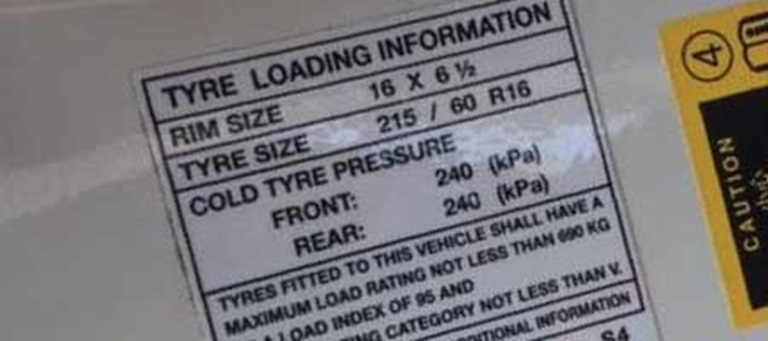
Step 2: Check your tyre pressure
You can check the pressure of your tyres using either an automatic air compressor, or a tyre pressure gauge. To do so:
- Unscrew the valve cap from your tyre.
- Attach your tyre pressure gauge, or the hose of the automatic air compressor, to the valve. You can see in the picture below where you’ll need to attach the hose or gauge.
- Check the kPA reading on the automatic air compressor or tyre gauge. You can then compare the results to the ideal tyre pressure, to see if your tyres need inflating.
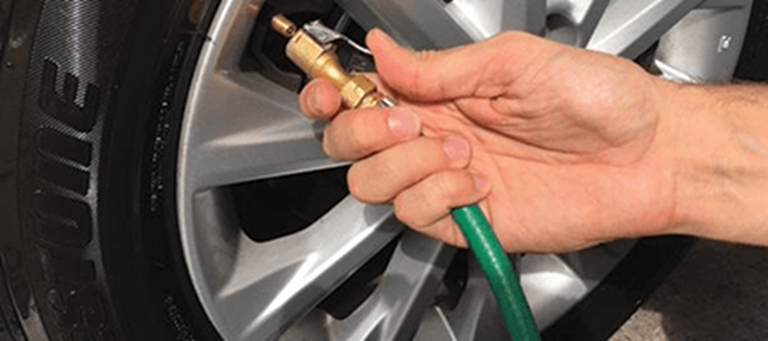
Step 3: Fill your tyres
Now, it’s time to refill your tyres to the perfect pressure. The process is slightly different depending on which type of air compressor you are using. Check which steps are right for you below, and make sure to always follow the instructions on your air compressor.
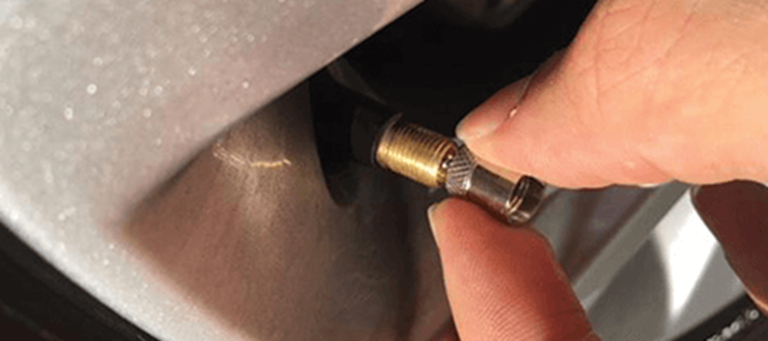
- If your air compressor allows you to set the desired tyre pressure, enter the correct kPA. Generally, this should be the recommended manufacturer pressure you found in step one. However, if you’ve recently driven your car more than 2km, and your tyres are hot, we’d recommend increasing the pressure by 20-50 kPA.
- Unscrew the valve cap from your tyre.
- Attach the air compressor hose to the valve. Make sure you put pressure on the hose so that air can’t escape while the tyre is filling.
- Press on the lever to fill your tyre. If you’re using an automatic tyre compressor, simply hold down the lever until you hear a beep. When the beep sounds, your tyres are at the set pressure. If you’re using a manual air compressor, press the lever and let air into your tyre in short bursts. Measure your pressure at regular intervals and repeat as needed.
- Check your tyre pressure, to make sure your tyres have been correctly inflated. Be aware that petrol station compressors can be inaccurate, so it’s best to check your tyres with your own tyre pressure gauge to make sure the pressure is perfect.
If you find your tyre is overinflated, release some air by turning the valve cap around and then pushing on the valve core, or with your fingernail. If you find your tyre is underinflated, reattach the hose and refill your tyres, slightly increasing the desired kPA. Check your tyre pressure again once you have finished.
Towing tyre pressure
Should you adjust your tyre pressure for towing?
Heavy loads or towing put an extra strain on your tyres and many tyre manufacturers will recommend a slightly higher tyre pressure. Check your manufacturer specifications.
Let's find tyres to suit you
Frequently asked questions
-
How to check tyre pressure?
To check tyre pressure, find the recommended PSI in your manual or Placard Sticker which is usually found in the vehicles door. Use a tyre pressure gauge on cold tyres, removing the valve cap first. Press the gauge onto the valve stem firmly to get a reading. Compare this with the recommended pressure. If low, add air using a compressor; if high, release air. Repeat for all tyres, including the spare. Replace valve caps securely. Regularly monitor tyre pressure, checking at least monthly and before long trips. Proper pressure ensures safety, extends tyre life, and improves fuel efficiency.
-
What PSI should car tyres be?
Most passenger cars in Australia require between 30–36 PSI (pounds per square inch). The correct PSI for your tyres depends on your specific vehicle, so always check the tyre placard inside the driver’s door, glove box, or fuel flap, or refer to the owner’s manual. Keeping tyres at the correct PSI improves safety, extends tyre life, and helps maintain fuel efficiency.
-
What pressure should car tyres be?
Car tyres should be inflated to the manufacturer’s recommended pressure, usually between 30–36 PSI (210–250 kPa) for passenger vehicles in Australia. SUVs, 4WDs, and utes may need higher pressures. You can find the exact figure on the tyre placard or in the vehicle manual. Correct tyre pressure improves handling, braking, fuel efficiency, and helps tyres wear evenly for longer life.
-
What is nitrogen tyre inflation and why use it?
Nitrogen tyre inflation is the use of pure nitrogen instead of regular air to inflate tyres. Because nitrogen molecules are larger than oxygen, tyres inflated with nitrogen hold pressure for longer. This can mean better fuel economy, longer tyre life, and more consistent performance for everyday driving. Nitrogen inflation can be used in almost any passenger car, SUV, 4WD or ute tyre that normally uses air. It isn’t essential for all drivers, but it may benefit those looking for steadier tyre pressure and less frequent top-ups. To learn if nitrogen inflation is right for you, speak with your local Bridgestone store.
